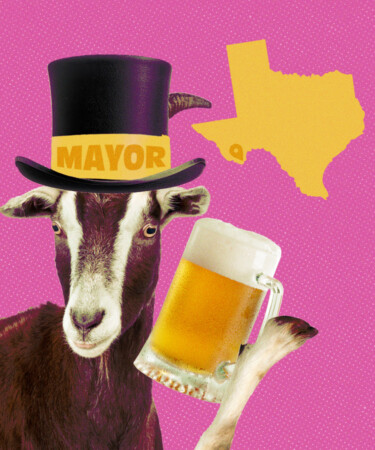Every town in the country, regardless of size, has some entity in place to handle political affairs. Most have a mayor, while others rely on a city council. But when a town is so small that it doesn’t technically qualify as a “town,” who runs the show?
Well, it depends. These places, formally known as unincorporated communities, often exist in rural areas or on the fringes of larger, established cities. More often than not, unincorporated communities have populations of fewer than a couple hundred people, and are both governed and policed by officials of the county in which they reside. Sometimes, a state’s military branch is in charge. Regardless of the situation, these communities need no mayor, but that doesn’t mean they can’t have one — even if it’s just for fun.
As such, there are many unincorporated communities across the country that have, or have had, animals as mayors. We’re not saying that these officials are ruthless, moralless people. They’re literally four-legged, furry creatures. There’s even a Wikipedia page that chronicles all the animals that have held political office in the U.S. over the years. None, though, are as iconic as Clay Henry and his kin: a long line of beer-loving goats that have served as mayor of Lajitas, Texas, for decades.
From Goat to G.O.A.T.
Back in the early ‘80s, a Houston businessman named Walter M. Mischer owned all the property in Lajitas, a small unincorporated community with fewer than 100 residents positioned along the Texas-Mexico border.
According to Texas Heritage For Living magazine, Mischer believed that Lajitas had a promising future as a resort town, so he invited some friends from Houston to come visit and help him figure out how to make that dream a reality.
Toward the end of their stay, an unexpected freak snowstorm pummeled Lajitas, so Mischer and his buddies sought refuge at the local watering hole. Over drinks, they decided that Lajitas needed a municipal government. The first step was electing a mayor.
One of Mischer’s visiting pals and the owner of a Houston construction company, Tommy Steele, seemed like the right guy for the gig, so Mischer and his cohorts encouraged him to run. However, when word got out, a Lajitas native named Bill Ivey got up in arms. He figured that if some hot-shot out-of-towner could run the show, his goat would be able to do it just as well. It sounds like a joke said in a fit of frustration — and maybe it initially was — but Ivey then actually nominated his goat, Clay Henry I, to run for mayor.
Ivey brought in his friend Jim Woodward from Uvalde, a city outside San Antonio, to help run Clay Henry’s campaign. Woodward got Ivey several radio interviews to promote the campaign, but the competition proved to be fierce, as Steele promised to buy a snowplow for Lajitas if he got the job — a deft and timely proposition.
Sure enough, Steele secured the victory, but lo and behold, when the next election rolled around a few years later, Clay Henry took his rightful position as the mayor of Lajitas. It remains unclear why the locals turned on Steele, but it’s likely that they didn’t want their humble community to turn into a full-blown resort town flooded with tourists.
Lone Star Beer, Cage Brawls, and the Clay Henry Dynasty
And so the long line of goat mayors had begun. Clay Henry’s municipal cage was — and still is — located a stone’s throw away from the local bar, which was dubbed “The Thirsty Goat Saloon” in his honor. Allegedly, it became standard practice for bar-goers to pick up a few Lone Star Beers and take them over to Clay Henry’s cage, where he would voluntarily chug them in rapid succession. Reports claim that he once drank between 35 and 40 beers in one day.
However, Clay Henry was not exempt from the pitfalls of excessive alcohol consumption. In 1992, he had a son, aptly named Clay Henry Jr., who was also partial to the sauce. Presumably in a drunken state, the two fought over a female goat, and Clay Henry Sr. was left dead at the end of the brawl. Nonetheless, Jr. assumed office, but resigned — whether that was by his own accord or not — in 1998.
Although Lajitas was without a mayor for a few years, things returned to bizarre normalcy in the year 2000. Another election was held, and Clay Henry III had to duke it out with a wooden Native American statue from a local trading post and a ranch dog named Clyde for the mayoral position. Somehow, some way, he clinched the win, reigniting the family legacy.
The Legend Lives — and Drinks — On
Clay Henry III’s tenure began as a smooth ride, but he eventually fell victim to some controversy. There were some skeptics in Lajitas who believed that he wasn’t a direct descendent of the other goat mayors — an uncertainty that was never officially debunked. He was also critically wounded during a particularly violent altercation in November 2001, but he miraculously recovered and retained his role.
This is when the story gets somewhat murky. At some point over the next few years, Clay Henry III stepped down, and Lajitas was without a mayor. In 2013, the office — or cage, technically — was still vacant. Luckily, order was restored a few years later when Clay Henry IV was elected mayor, ushering in a new era of political stability in Lajitas.
As of February 2024, Clay Henry IV was still in office, drinking beers like the many Henrys that came before him. Nowadays, it’s unclear whether or not he is still mayor, but there remains a Clay Henry (either IV or V) keeping the peace in Lajitas, bringing tourists in from faraway lands, and chugging brews like nobody’s business.
*Image retrieved from Creaturart via stock.adobe.com
